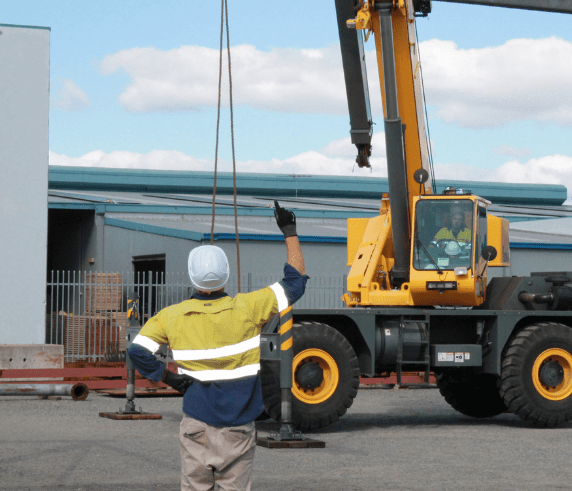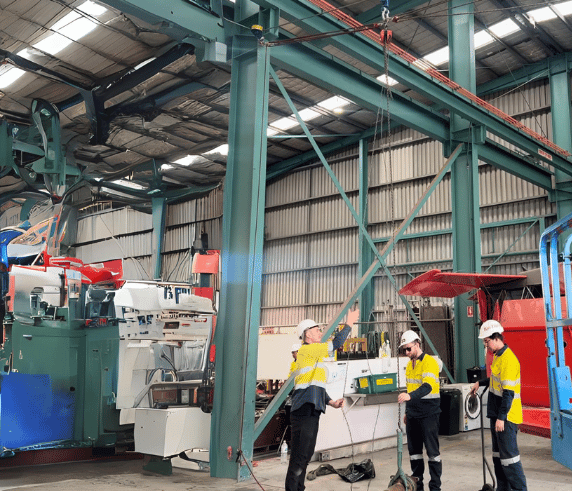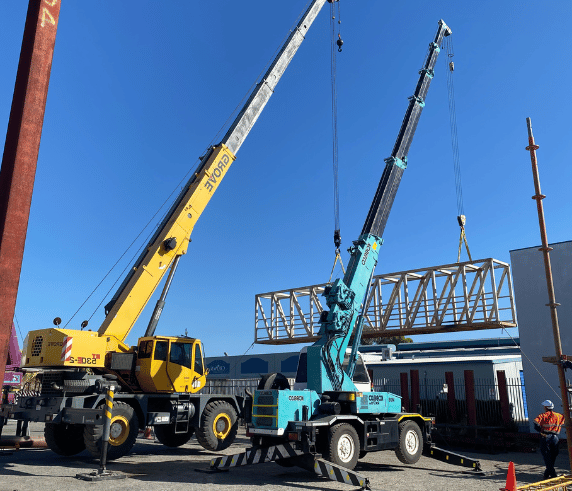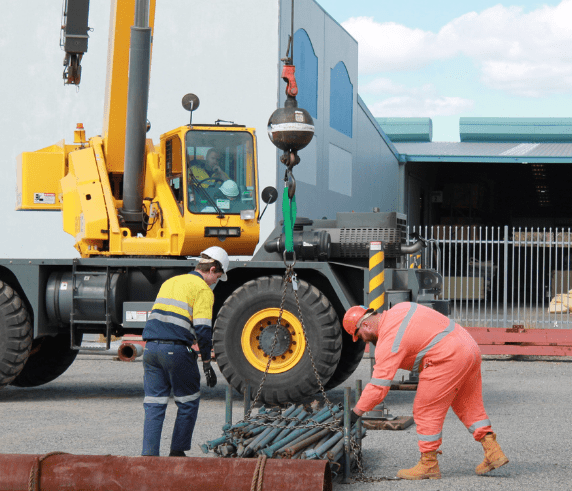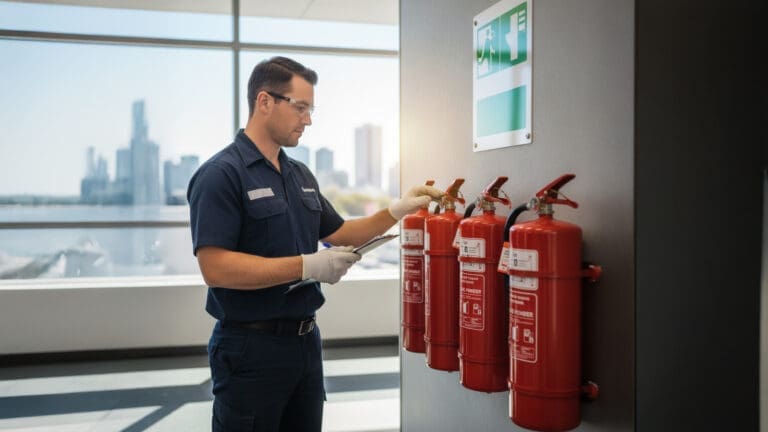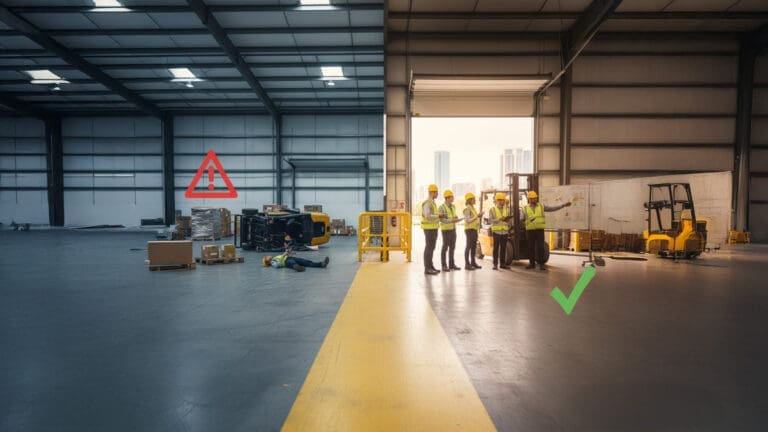Saferights Dogging course is one of our most popular courses, and for good reason! Dogging is a vital role in the construction and industrial sectors, ensuring safety and efficiency in lifting operations. If you’ve ever wondered about the specifics of what a dogman does, how it differs from rigging, and how to become a qualified dogman, you’re in the right place. This guide will walk you through everything you need to know about Dogging.
What is Dogging?
What exactly is dogging? Dogging is the process of directing and managing the safe lifting and movement of loads using cranes and other lifting equipment. The term “dogging” originates from the practice of guiding and controlling the movement of loads, akin to how a dogman (or dogger) would manage and direct lifting operations. Dogging requires technical knowledge, strong communication skills, and practical expertise when handling loads safely and efficiently.

Key aspects of dogging include:
- Lifting Equipment Coordination: Collaborate closely with crane operators and riggers to use lifting equipment correctly and safely.
- Communication: Using hand signals or radios to provide clear instructions to crane operators and other team members during lifting operations.
- Safety Monitoring: Follow all safety protocols and procedures to prevent accidents and maintain a safe working environment.
- Transport and Logistics: Handle and transport large goods or containers in warehouses or logistics hubs.
- Shipyard and Dock Operations: Lift and maneuver large parts or vessels into place in shipyards.
What does a Dogman do?
A dogman, also known as a dogger, plays a crucial role in ensuring the safe and effective movement of loads on construction sites and industrial environments.
The primary responsibilities of a dogman include:
- Directing Cranes and Lift Operations: Using hand signals or radios to communicate with crane operators and guide the lifting and placement of loads.
- Load Calculation and Assessment: Evaluate the weight and stability of loads to ensure they are securely fastened before lifting.
- Securing Loads: Attaching and detaching loads using various rigging techniques, including slings and chains.
- Safety Compliance: Ensuring that all lifting operations adhere to safety regulations and standards to prevent accidents.
What are the benefits of becoming a Dogman?
Becoming a qualified dogman offers numerous benefits, from enhancing safety and compliance to opening up job opportunities and increasing earning potential. Knowing how to perform your duties correctly not only boosts your confidence but also ensures the safety of everyone on site.
Employers consider dogging skilled labor, which typically commands higher hourly rates than unskilled work. Additionally, proper technique in dogging is less physically demanding than general labour, making it suitable for a wide range of ages, from young workers to experienced professionals. (Please note: You must be 18 years or older to obtain a DG licence in Australia.)
Whether you’re new to construction or already in the field, obtaining a Dogging ticket can significantly improve your career prospects. This qualification is also valuable in industries beyond construction, including transport, mining, and other heavy sectors.
What is a Dogging Licence?
You need a Dogging licence (Licence to perform dogging – CPCCLDG3001) to legally perform dogging tasks. It demonstrates that an individual has the necessary skills and knowledge to handle lifting operations safely. The dogging licence is governed by the National High Risk Work Licence (HRWL) framework in Australia, ensuring that workers doing this role are properly trained and assessed.
To obtain a dogging licence, candidates must:
- Complete a Training Course: Enrol in a nationally recognised dogging course that covers both theoretical and practical components.
- Pass a Competency Assessment: Successfully complete an assessment that evaluates your ability to perform dogging tasks safely.
- Apply for the Licence: Submit an application to the relevant state or territory authority, including proof of training and assessment.
Who needs a Dogging licence?
A dogging licence is crucial for roles that involve lifting and moving heavy loads. Jobs that require a dogging licence include:
- Construction Site Dogman: Operating on building sites, ensuring that cranes and other lifting equipment safely move construction materials and equipment.
- Industrial Crane Operator: Working in factories or industrial plants, where precise lifting and placement of heavy machinery or materials are necessary.
- Mining Operations: Heavy machinery and equipment need to be lifted and positioned safely In the mining industry.
- Transport and Logistics: In warehouses or logistics hubs, where large goods or containers are handled and transported.
- Shipyard and Dock Operations: In shipyards, where large parts or vessels are lifted and maneuvered into place.
Dogman vs. Rigger: What’s the Difference?
While both dogmen and riggers play essential roles in lifting operations, their responsibilities differ significantly:
Dogman
Dogman focuses primarily on the safe movement of loads, including directing crane operators, securing loads, and ensuring compliance with safety regulations. Dogmen work closely with crane operators to ensure that loads are lifted and placed correctly.

Rigger
Specialises in the setup and dismantling of rigging equipment, such as hoists, pulleys, and slings. Riggers are responsible for preparing the equipment used in lifting operations, ensuring that it is correctly installed and capable of handling the loads.

In summary, a dogman manages the operational side of lifting and securing loads, while a rigger prepares and sets up the equipment used for these operations.
How to Become a Dogman
1. Gain a Qualification for Dogging
If you wanted to become a Dogman the first step is to start your training to gain the necessary skills from a training organisation. There are a few pathways to gain the necessary training involved to become a Dogman, however, Registered Training Organisations (RTO’s) offer the most comprehensive unit of competency is (Licence to perform dogging – CPCCLDG3001). This is usually 4–5-day course that leads to a licenced outcome. It includes theoretical and practical training. You’ll need to complete a portfolio of work to be competent in that unit.
Saferight Training Academy is an RTO that offers top-tier courses in Western Australia, designed for all skill level. Enrol our dogging course (Licence to perform dogging – CPCCLDG3001) to gain the necessary skills and knowledge needed.
2. High Risk Work Licence (HRWL) for Dogging
- Why It’s Important: After completing the necessary training and earning your qualifications, the next crucial step is obtaining a High-Risk Work Licence. This licence is mandatory for performing Dogging work in Australia, ensuring that only trained and competent individuals are allowed to perform high-risk tasks.
- How to Obtain the Licence: You can apply for this licence through WorkSafe or via the training organisation where you completed your scaffolding qualification. Saferight has this service with a additional fee, this makes it easier for you to get licensed and start working right after your qualified.
3. Obtain a white card
- What is a White Card? The White Card, or also known as the ‘Construction Induction Training Card’, is an essential certification for anyone intending to work in the construction industry in Australia. It proves that you have completed the necessary general construction induction training, focusing on workplace health and safety (WHS) standards.
- Why is it Important? Without a White Card, you cannot legally work on a construction site in Australia. It ensures that all workers understand the fundamental safety practices required to maintain a safe working environment, reducing the risk of accidents and injuries on site.
- How to Get a White Card: To obtain your White Card, you must complete a short course provided by a registered training organisation (RTO). The course typically takes a day and covers essential topics such as identifying and managing risks, understanding safety laws, and knowing how to respond to potential hazards.
- Where to Apply: White Card courses are widely available across Australia, and usually offered by Registered Training Organisations. ‘Prepare to work safely in the construction industry – CPCCWHS1001’ is what you need to search for. After completing the course successfully, you’ll get a White Card that is recognised across the country, allowing you to work on any construction site in Australia.
4. Additional Tickets
Having a Dogging ticket and your white card is a great way to start out, but having additional tickets under your belt makes you a more desirable candidate if you’re looking for work in the mining and construction industry. For more information on additional High-Risk course, view our course categories.
5. Start Building Your Resume
With all the necessary licences and qualifications in hand, it’s time to start building your resume. Many companies are open to hiring individuals with little to no experience, often providing on-the-job training as you embark on your career. This is a great opportunity to gain practical experience and grow your skills in a real-world environment.
Looking to Start Your Dogging Career?
If you’re ready to become a qualified dogman and take on this crucial role in the construction and industrial sectors, Saferight Training Academy has the perfect courses for you. Our dogging course is built to provide you with knowledge and skills for certification needed to excel in this field.
Enroll in Saferight’s Dogging Course Today!
By choosing Saferight, you’ll benefit from expert instructors, hands-on training, and a nationally recognised qualification that sets you on the path to a successful career. Don’t miss out on the opportunity to become a skilled dogman and enhance your career prospects. Let’s get started on your journey to becoming a qualified dogman!
